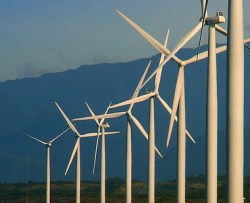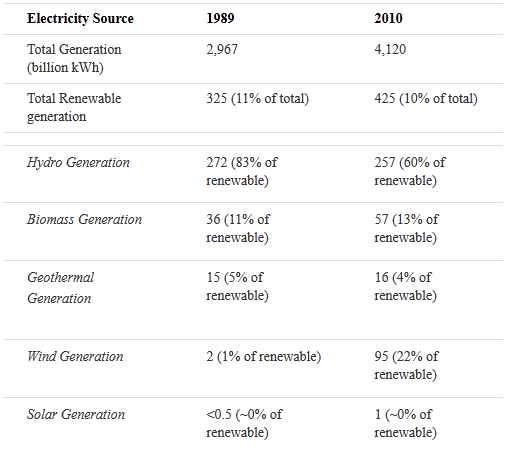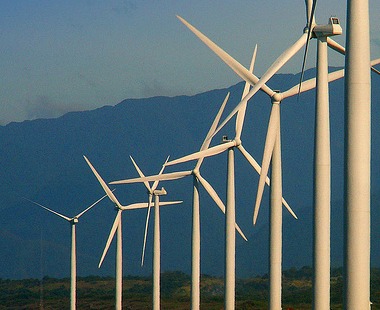
Photo by stormcrypt.
There’s a bunch of discussion right now on renewable electricity vs. baseload electricity. David Roberts gives a good German example here. Chris Nelder goes so far as to suggest that thanks to renewables, “baseload is doomed,” while John Farrell suggests that renewable energy is the new and sexy iPad, destined to replace the old baseload typewriter. Meanwhile, in utility land, we see issues like the one that took place in the Northwest last year, with Bonneville Power Association (BPA) forcing the curtailment of wind turbines, on the claim that the grid could not readily accommodate the rising percentage of intermittent resources.
So is BPA just a Paleolithic typewriter sales rep, or are these smart writers missing something fundamental about the power grid? I suggest to you that both are right — but that the debate is focusing on the wrong axis. As evidence, consider that the percent of power generated from renewable energy in the U.S. today is virtually the same as the percent of power we generated from renewable energy 20 years ago. If something dramatic is happening in renewable energy that is disrupting the old paradigm, it hasn’t happened yet. So then why is there so much noise about the sudden challenge integrating renewable energy into our grid?
The simple answer is that it’s easy to integrate renewable energy into the grid, and you’d be hard pressed to find anyone who disagrees. What’s hard to integrate is intermittent, non-dispatchable energy into the grid, which is only a small subset of renewable energy. Moreover, these resources don’t compete in any meaningful way with baseload assets — but they have big consequences on other intermittent dispatchable sources.
In other words, this is not a conversation about renewables or baseload. It is a conversation about wind.
Our electric system long ago learned to deal with demand volatility: You turn on your lights, turn off your TV, and the grid immediately adjusts the power output of some generator on the system. In most cases, this is done with intermittent, quick-dispatchable resources. Sometimes that’s hydro, but usually it’s a mix of engines and gas turbines that are cheap to install and capable of very rapid startups and shutdowns. Coal and nuclear (aka “baseload”) are neither cheap to install nor capable of rapid shifts in output, so really don’t serve this function except in extreme cases.
Historically, the U.S. renewable mix has been dominated by baseloaded, or, in the case of big hydro with upstream reservoir capacity, dispatchable sources. Those have proven fairly easy to integrate into the system; biomass and geothermal compete with coal and nuclear to serve the base demands of the system, and hydro swings, acting sometimes as a baseload resource and other times as an intermittent resource that can quickly swing capacity up or down.
What’s changed in recent years is wind — and in particular, large-scale wind farms that (at least proportionally) have come at the expense of virtually all other renewable sources. Over the last 20 years, there’s been very little growth in generation from renewables on a percent basis. What’s changed is the mix:

In 1989, the easy-to-integrate stuff (hydro, biomass, geothermal) accounted for 99 percent of the renewable mix. By 2010, they made up just 77 percent of the renewable mix, as wind has grown from essentially zero to 22 percent of total U.S. renewable generation.
This is a key point: Renewables are no more difficult to integrate into the grid than Indian food is difficult to integrate into a healthy diet. The challenge grid managers face is the rising concentration of wind within that mix. It is a deep-fried lamb samosa: really tasty and great in moderation, but hopefully not the biggest portion on your plate.
The challenge that wind has created for system managers is that it has introduced a whole new variable into system management — supply volatility. Loads (demand) are still tripping on and off with some degree of random fluctuation, but we now find ourselves with significant portions of the generation supply tripping on and off in random ways, at volumes that are really hard to handle. This National Renewable Energy Laboratory report [PDF] suggests that by 2020, the variability of generation in the western U.S. could be 57 times greater than the variability of demand. That’s an enormous challenge.
To be clear, supply volatility isn’t hard in small doses. Every generation technology is subject to random, unplanned outages, and you cannot manage the grid without taking that potential into account. For big swaths of the U.S. power grid, we can accommodate much greater penetration of wind without any difficulty.
The challenge arises when the penetration of those resources within a certain control area exceeds the megawatt rating of the largest single generator in any given control area.
Since the grid has already been designed to accommodate an outage of their biggest generator, any system-wide reduction in wind turbine output below that level is already planned for. The issue arises when there is a statistical possibility of a regional weather-dependent outage that exceeds the size of that large generator.
This is a matter of law as much as a matter of technology. The North American Electric Reliability Corporation (NERC) requires grid managers to ensure that the probability of a blackout is less than one day in 10 years, and if a grid manager cannot accommodate swings that are within that statistical possibility (as regional wind variation most certainly is), they are in deep legal doo-doo.
Until recently, that hasn’t mattered much with respect to renewable integration, but the dramatic growth in wind has changed this dynamic. Nationally, wind contributes just 5 percent of total U.S. megawatt-hours, so there should be ample room to grow. But the NERC standards necessarily impose regional constraints; the stability of the system in Maine doesn’t make a lick of difference to the West Texas system operator, and the 5 percent of generation from wind is concentrated in a few local pockets. (More than half of all the wind generated in the U.S. in 2010 was in just five states: Texas, California, Iowa, Washington, and Minnesota.)
This site from BPA shows the realities facing a grid manager: Wind can account for 25 percent of their instantaneous generation. Since the total wind on the system can (and often does) go from full capacity to zero over fairly short intervals (and vice versa), they have to have some other resource in hand that can instantaneously “mirror” those swings — in their case, hydro plays that role, so long as reservoir capacity and aquaculture considerations allow.
BPA’s hydro capacity makes it an exceptional case, though; for most of the grid, the swing generator that can immediately dispatch up or down is a gas turbine. Also note that while much is made of wind’s potential to suddenly turn off, its ability to suddenly turn on must also be managed.
Outside of BPA, this means that utilities are today keeping a fleet of gas turbines running in hot standby, burning fuel but not generating power so they can instantly ramp up when the wind dies. At the same time, they’ve got gas turbines running full-throttle so they can instantly ramp down when the wind picks up. As a practical matter, this means that continued increases in the penetration of wind on the system must be accompanied by an increase in natural gas combustion (a point T. Boone Pickens keenly understands). This raises a whole host of challenges, not all of which are environmental. For starters, the natural gas transmission system is not designed for the same reliability levels that NERC demands of the power fleet, so an increase in the percentage of power we get from natural gas is implicitly reducing the overall reliability of the system.
Solutions
To be sure, these are solvable problems. If we could find the money and the political will, we could install lots of high-voltage direct current transmission and take advantage of the fact that the wind is always blowing somewhere. If we could invent low cost, high charge/discharge cycle energy storage we could eliminate the need for spin-up/spin-down generation, storing the output of wind farms until it can provide the most value to the grid.
Maybe those solutions will come to pass, but note that in both cases, their obstacles are financial, technological, and political (NIMBY, etc.). Perhaps we should solve those problems, but it’s not clear we can. It’s also not clear that the resources required to solve those problems are the most cost-effective route to a clean and renewable future. The fact that it may be possible to develop a nutritionally complete, healthy samosa doesn’t mean that should be a priority of our food industry.
The bottom line is that wind — just like any other power source — is dangerous at high doses. Clean energy is perfectly compatible with a reliable electric grid, and wind is a critical part of a clean and reliable future. But only in moderation, as part of a balanced grid diet.
On the whole, this is a good thing. We have lots of history integrating clean energy into the U.S. power grid, and there is no reason we cannot continue to do so. But there are real dangers associated with an over-concentration on any single resource that we cannot ignore.



